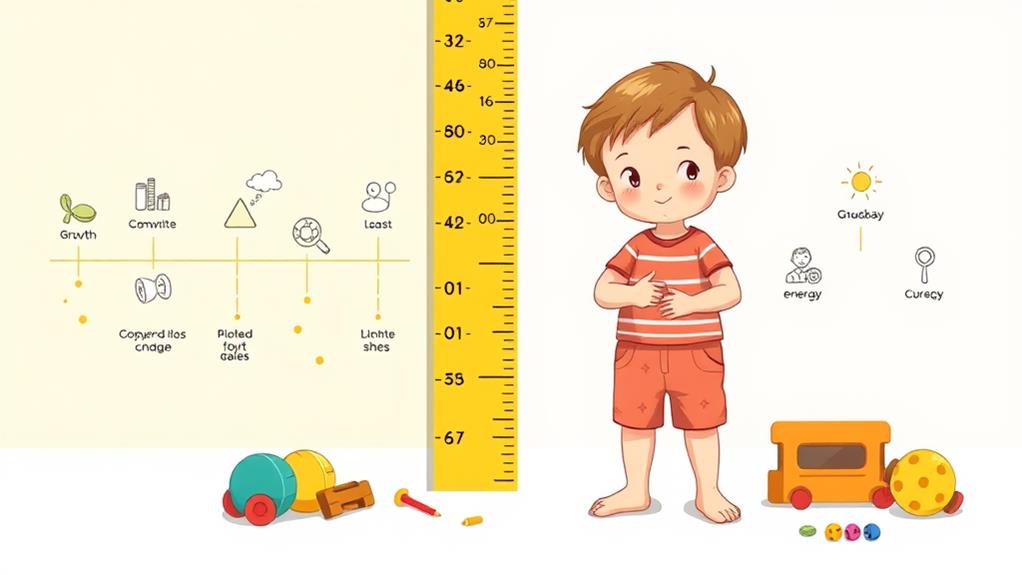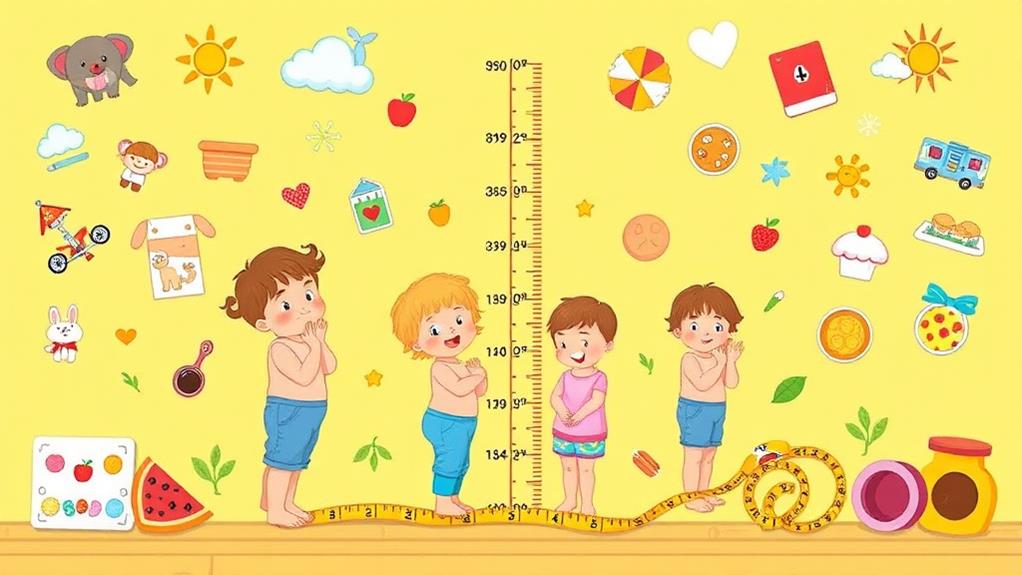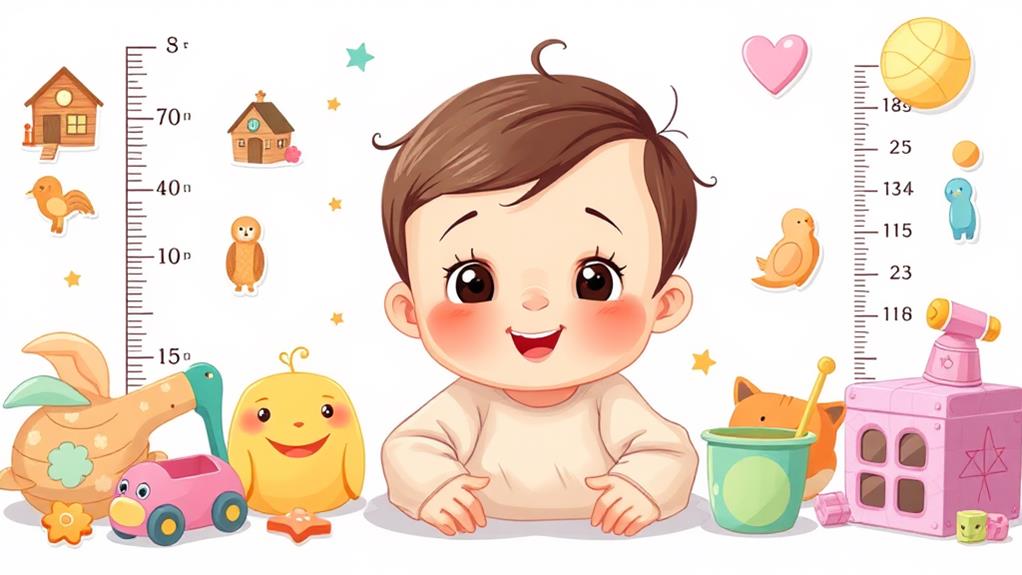As a parent, you've likely noticed fluctuations in your toddler's behavior and appetite, which can often signal a growth spurt. These periods of rapid development generally occur at specific ages, and recognizing the signs can help you better support your child during these times. From increased irritability to sudden hunger, understanding these changes is crucial. But how can you effectively monitor and respond to these growth spurts to ensure your toddler's well-being? The answers might surprise you, as they encompass more than just nutrition and sleep.
Definition of Growth Spurts

A growth spurt is a specific period when your toddler experiences rapid increases in height and weight. It's like they suddenly decide to shoot up overnight!
These growth spurts are common during toddlerhood, especially between the ages of 1 and 3. You might notice that your little one gains about 5 pounds and grows 4 to 5 inches in height from ages 1 to 2. Then, from ages 2 to 3, they might add another 4 pounds and grow 2 to 3 more inches.
Growth spurts usually last from 2 to 7 days, and they often sneak up on you. You mightn't even realize it's happening until after it's over.
So, what're the signs of growth spurts? Well, you may see increased hunger as they munch like a little squirrel, or they might seem more tired and cranky than usual. Those emotional shifts can feel like a rollercoaster ride, too!
Recognizing these signs of growth spurts helps you understand your toddler's changing needs. Just remember, it's all part of the amazing journey of toddler growth!
Key Ages for Growth Spurts
During those early years, you'll notice that certain ages are particularly significant for growth spurts in your toddler. From about ages 1 to 2, your little one will likely gain around 5 pounds and grow 4 to 5 inches taller. That's quite a leap!
Then, from ages 2 to 3, expect another growth spurt where they typically gain about 4 pounds and grow 2 to 3 inches. By ages 3 to 4, they'll continue to stretch, adding around 4 to 6 pounds and the same 2 to 3 inches in height.
After these big years, toddlers usually grow 3 to 4 inches and gain 3 to 4 pounds each year until they hit puberty.
While growth spurts can pop up at any time, these first three years are when you'll see the most noticeable changes in your child's physical development. So, keep an eye out! It's like they're on a secret mission to grow tall enough to reach that cookie jar on the counter.
These key ages are exciting times to watch your toddler growth unfold, as they're turning into the little people they're meant to be!
Duration and Signs

Noticing your toddler's growth spurts can be exciting, but it's also important to understand how long these phases last and what signs to look for. Typically, growth spurts in toddlers last anywhere from 2 to 7 days. Infants, on the other hand, might experience shorter spurts that last up to 3 days. So, if you see changes in your little one, it's likely just a temporary phase!
Common signs of growth spurts include an increased appetite, so don't be surprised if they suddenly want to eat everything in sight! You might also notice more fatigue, fussiness, and emotional fluctuations.
Growing pains can show up as dull aches in their legs, but these are often linked to all that extra running around rather than actual growth.
Another sign to watch for is changes in sleep patterns. Your toddler might sleep longer or wake up more during the night.
Lastly, keep an eye on their clothes; if they're suddenly outgrowing sizes, it's a good indicator that a growth spurt has occurred.
Nutritional Needs During Growth
Supporting your toddler's nutritional needs during growth spurts is crucial for their overall development. During these times, they need extra calories to fuel their rapid growth, so it's important to focus on nutrient-dense foods. Think fruits, vegetables, whole grains, and proteins—basically, the superheroes of healthy growth!
Don't forget about hydration; your little one might need more water than usual to stay refreshed and energized. Calcium and vitamin D are also key players during growth spurts, helping build strong bones. So, make sure to include dairy products or fortified alternatives in their meals.
Regular meals and healthy snacks are a great way to combat those sudden hunger spikes that many toddlers experience. You know, the ones where they suddenly devour everything in sight?
Offering balanced nutrition throughout the day helps keep their energy steady and supports their growth.
Monitoring Growth Patterns
Keeping an eye on your toddler's growth patterns is key to ensuring they're developing as they should. Regular pediatric check-ups are essential for this.
At these visits, your doctor will assess your child's height and weight against standardized growth charts. These charts use percentiles to compare your toddler's measurements with those of their peers, helping you spot any significant deviations or concerns.
It's also important to keep your family's growth history in mind. Genetics can play a huge role in how your child grows and what their potential height might be.
Documenting milestones and growth changes can help you catch any potential growth issues early, allowing for timely interventions if necessary.
Emotional and Physical Impact
Often, toddlers go through emotional and physical changes during growth spurts that can be challenging for both them and their caregivers. You might notice your little one experiencing emotional fluctuations, like sudden irritability or outbursts. These feelings often come from the discomfort of growing pains, which can cause dull aches in their legs.
It's tough when they can't express what they're feeling, isn't it?
Sleep deprivation plays a big role, too. When growth spurts disrupt their sleep, it can lead to a cranky toddler, making your days feel longer than they should! Plus, with their sudden increase in appetite, they might seem like they're always asking for snacks. It's because they need more calories to fuel their rapid growth, which can leave them bouncing off the walls one minute and moody the next.
As their bodies change, they might also struggle with their self-image, leading to some behavioral adjustments.
Understanding Growth Charts

Tracking your toddler's growth can feel overwhelming, but understanding growth charts makes it easier. Growth charts are handy tools that track your child's height, weight, and head circumference over time. They help visualize how your little one is growing compared to other kids the same age and sex.
The CDC recommends using WHO growth charts for children aged 0-2 years, and CDC charts for those 2 years and older.
When you look at a growth chart, you'll see percentiles ranging from the 5th to the 95th. These percentiles show how your child's measurements stack up against their peers. For example, if your toddler's height is in the 75th percentile, they're taller than 75% of kids their age.
If you notice your child crossing two or more percentile curves, it might signal a growth delay or other health concerns, so it's a good idea to reach out to a healthcare provider.
Supporting Toddler Development
During toddlerhood, supporting your child's development is crucial for their overall growth and well-being. You want to make sure they're getting a well-balanced diet, filled with fruits, vegetables, whole grains, and proteins. This is especially important during growth spurts when they're growing like weeds!
You'll also want to ensure they're getting adequate rest. Toddlers need about 10 to 14 hours of sleep each night to help those little growth hormones do their job.
Physical activity is another key part of supporting toddler development. Encourage your child to play, jump, and run around—both structured activities and free play are great. It helps build strong muscles and bones, and those little motor skills are going to shine!
Don't forget about hydration, either. Keeping your toddler hydrated is vital, especially when they're growing fast.
Lastly, routine pediatric check-ups using growth charts can help keep track of your little one's progress. It's a fantastic way to catch any potential growth issues early, ensuring your child stays on the right track.




